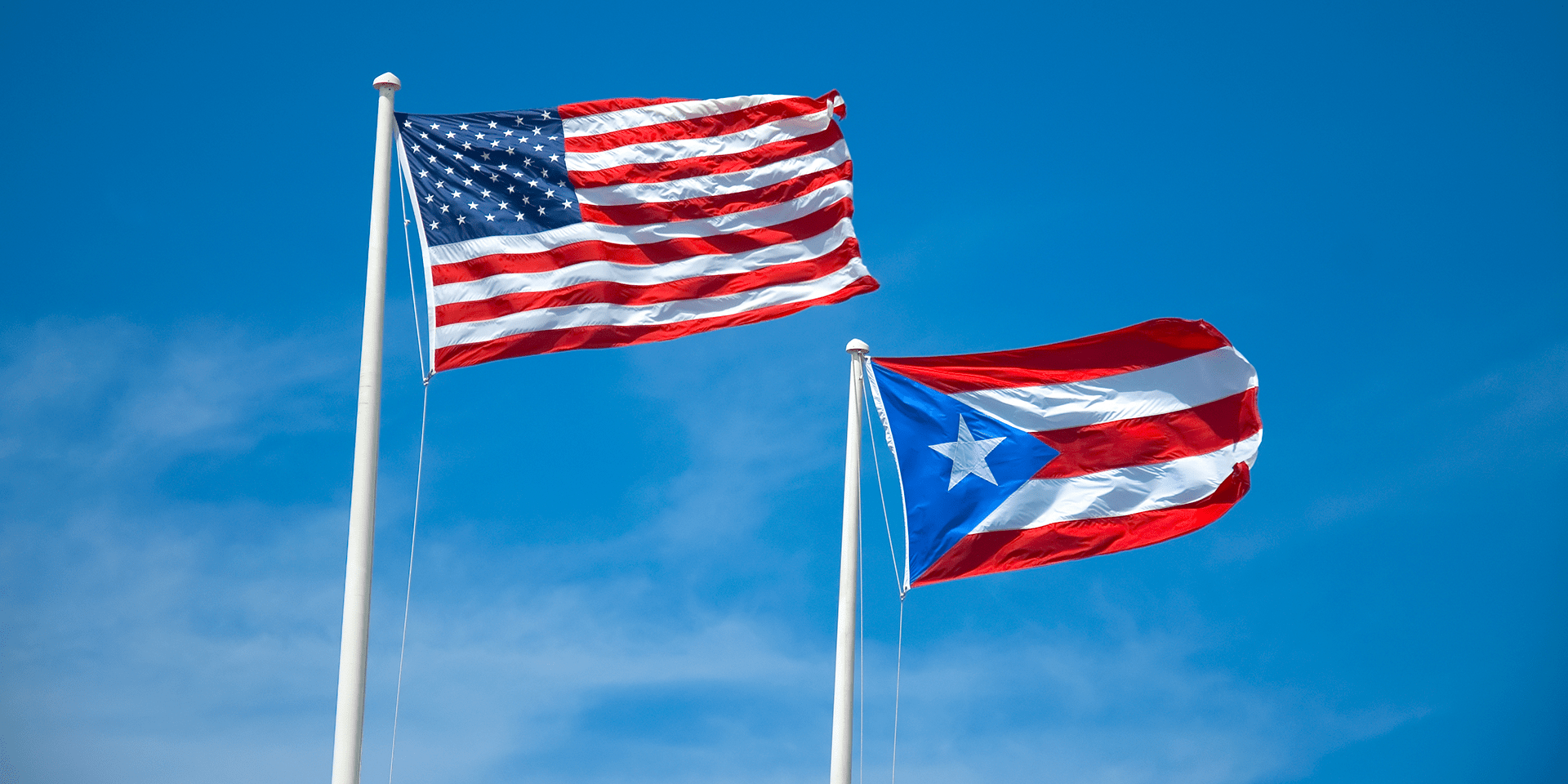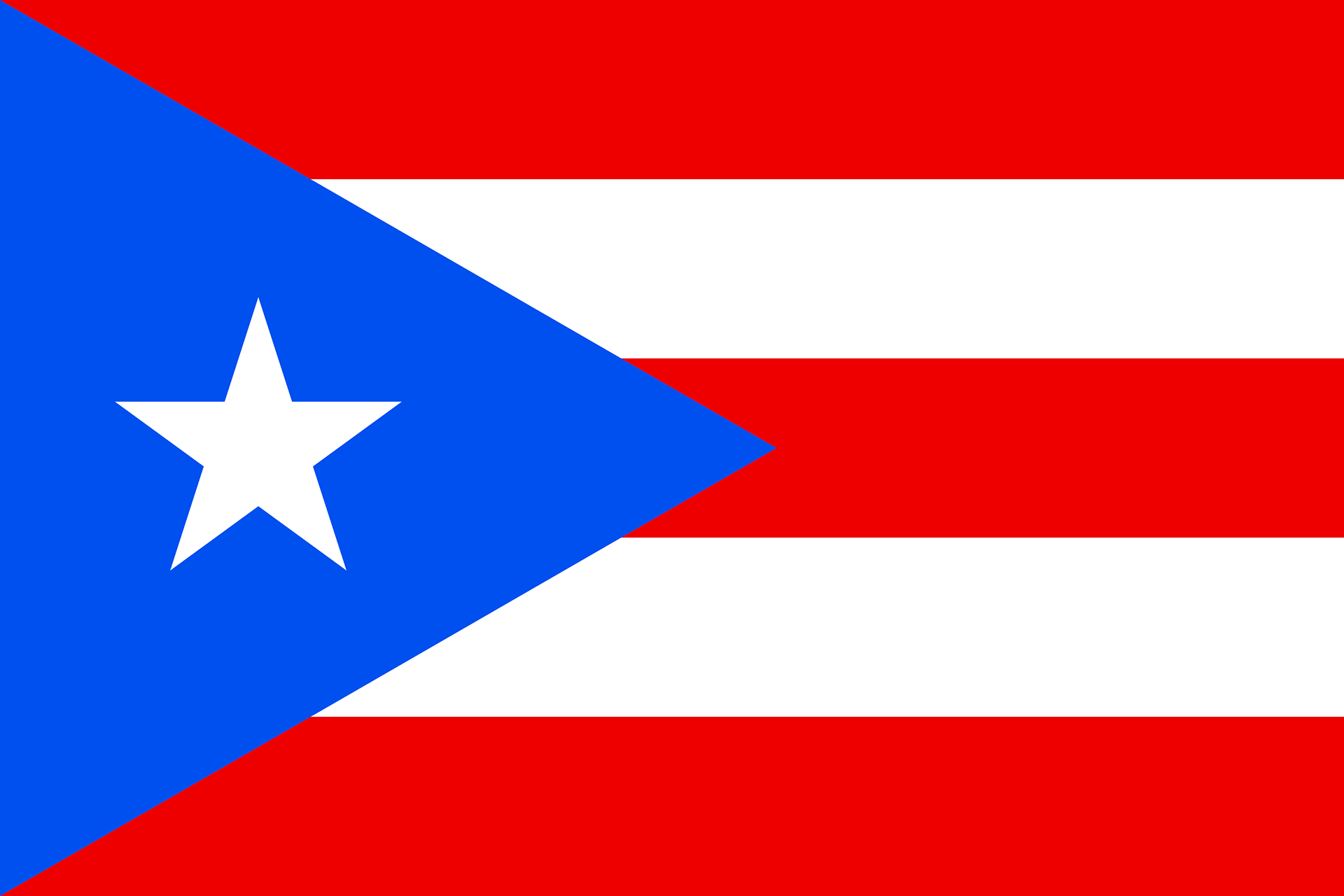The Flag of Puerto Rico

Despite popular misconceptions, the Puerto Rican flag was not based on the United Stated flag. The design of The Flag of the Commonwealth of Puerto Rico reflects the close ties that bound the Cuban and Puerto Rico patriots in the 19th century for the flag which waves over the Capital of San Juan is the Cuban flag color reversed.
The Puerto Rican flag's history run deep with pro-independence sentiments from Spanish dominion, and later United States rule - a symbol of pride, defiance, and protest.
In order to understand the flag's past, we need to go back to the 19th century when the first major revolt in 1868, known as El Grito de Lares (Cry of Lares) ocurred. Frustrated by the lack of political and economic freedom, and enraged by the continuing repression on the island, Puerto Rico's pro-independence movement staged an armed rebellion in 1868.
The rebellion broke out on September 23, 1868. It was planned by a group led by Dr. Ramon Emeterio Betances and Segundo Ruiz Belvis, from their exile in the Dominican Republic. Betances authored several proclamas, or statements, attacking the exploitation of the Puerto Ricans by the Spanish colonial system and called for immediate insurrection. The revolts started in Lares, and spread out to San Sebastian, but soon after the insurgents encountered a strong resistance from the Puerto Rican militia and retreated back to Lares. Upon an order from the governor, Julian Pavia, the militia soon rounded them up, and the insurrection was over. Many of the local leaders and participants were arrested, and some were executed. Those who survived their prison terms were later released and some went into exile, especially in New York City.
Although the revolt failed to achieve its main objective, the Spanish government granted more political autonomy to the island.
Twenty-four years later, in 1892 the Puerto Rican Revolutionary Committee was founded in New York, a political group affiliated to the Cuban Revolutionary Party, which advocated independence for Puerto Rico and Cuba from Spanish rule.
Dr. Jose Julio Henna was appointed President, along Juan de Mata Terreforte, vice president; Manuel Besosa and Sotero Figueroa, vowels; Gumersindo Rivas, secretary of minutes (later replaced by Roberto H Todd) and Gerardo Forrest, secretary of correspondence.
As part of their activities, a flag was created to rally support for independence from Spain. The flag was first used on December 22, 1895, when a group of 59 Puerto Ricans led by Dr. Jose Julio Henna, gathered at "Chimney Corner Hall" in Manhattan, New York City to promote the ideal of Puerto Rican independence from Spain. Other members of included participants of El Grito de Lares: Ramon Emiterio Betances, Juan Ruiz Rivera, Juan de Mata Terreforte and Aurelio Mendez Martinez. The flag was soon adopted as a national symbol.
On March 24, 1897, the Puerto Rican flag was used in the Intentona de Yauco (the Attempted Coup of Yauco), the second and final major revolt against Spanish colonial rule in Puerto Rico, staged by the island's pro-independence movement in the second half of the nineteenth century.
In 1898, the flag also became the mark of resistance to the US invasion; and in the 1930s it was adopted by the Nationalist Party. Blanca Canales proclaimed the Republic of Puerto Rico in Jayuya in 1950 using this flag and Lolita Lebrón deployed it during the attack on Congress in 1954. Soon after the Cuban Revolution (1953-1958) US officials in the island became suspicious of those who displayed the flag, considering them subversives. Police used to arrest anyone displaying the flag on charges of insubordination against the United States.
It was not until July 25, 1952, when Puerto Rico became a Commonwealth that the flag was officially adopted as the national flag.
Meaning Of The Flag
The Puerto Rican flag consists of 5 alternate red and white stripes. On the left of the flag is a single white five-pointed star resting in a blue triangle.
The three red stripes symbolizes the blood from the brave warriors, the two white stripes victory and peace after obtaining independence, blue symbolizes the sky and sea and the white star is the island.
In 1952 when Puerto Rico became a commonwealth, the flag was officially adopted, but it symbolism was altered to distance the flag from its history, along the blue, it was changed to a darker tone to make it similar to the American flag.
The symbolism is explained thus. The white star stands for the Commonwealth of Puerto Rico while the three sides of the equilateral triangle together represent the three branches of the Republican government (executive, legislative and judicial branches). The three red strips symbolize the blood that feeds those parts of the government. The two white stripes symbolizing the rights of man and the freedom of the individual, are a perpetual reminder of the need for vigilance of a democratic government is to be preserved.
The flag is not flown except in company of the U.S. flag. It should always stay to the left of the U.S. flag and both are to be flown at the same height. The Puerto Rican flag should be raised after the United States' flag is risen and put down before the United States' flag.
In 1995 the triangle color was changed again to sky blue. Therefore, there still circulating two versions for the flag, one with the darker blue and another with the lighter blue.
Flag of the United States

The flag of the United States of America, often referred to as the American flag or U.S. flag, is the national flag of the United States. It consists of thirteen equal horizontal stripes of red (top and bottom) alternating with white, with a blue rectangle in the canton (referred to specifically as the "union") bearing fifty small, white, five-pointed stars arranged in nine offset horizontal rows, where rows of six stars (top and bottom) alternate with rows of five stars. The 50 stars on the flag represent the 50 states of the United States of America, and the 13 stripes represent the thirteen British colonies that declared independence from the Kingdom of Great Britain, and became the first states in the U.S.
The current design of the U.S. flag is its 27th; the design of the flag has been modified officially 26 times since 1777.
Origin Of The Flag
The identity of the flag's creator has long been source of controversy.
Juan de Mata Terreforte attributes the origin of the flag to Francisco Gonzalez (Pachin) Marin, who wrote to him from Jamaica suggesting the idea of inverting the colors of the Cuban flag.
Another version states that Antonio Velez Alvarado argues that on June 11, 1890 or 1891, he reversed the colors of the Cuban flag and so it occurred to him to form the Puerto Rican flag. Antonio Velez Alvarado also states that the Puerto Rican flag was embroidered by Maria Manuela "Mima" Besosa, as narrated by Roberto H. Todd, founder of the Puerto Rico Republican Party.
The other version, Roberto H. Todd claims that it was Manuel Besosa, a member of the Board of Directors of the Puerto Rico Section, who decided the flag of Puerto Rico.
Flag of Spain
The "Cross of Burgundy," the Spanish military flag used from the 16th to the 18th century to identify warships, forts, and regiments of troops loyal to the king of Spain is still flies alongside the U.S. and Puerto Rican Flags at El Morro and San Cristobal as a tribute to the local infantry regiment that saw action during the British invasion of Puerto Rico in 1798, the Franco-Spanish war of 1809 and the war of 1812 in Louisiana. The regiment was later disbanded in 1815 by King Fernando VII.
Flag Day
Flag Day is celebrated on December 22. It commemorates when the flag was first raised. On December 22, 1895, a group of 59 Puerto Ricans, gathered at "Chimney Corner Hall" in Manhattan, New York City to promote the ideal of Puerto Rican independence from Spain. The city of Manati also celebrated Flag Day on June 11, the date when the flag was created.
Puerto Rico has maintained the same flag for the last 124 years.
The Puerto Rico flag was voted 7th best out of 71 flags ranked by the North American Vexillological Association in 2001.
Flag Specifications
The 3 main colors in the Puerto Rico flag are Red (#FF0000), White (#FFFFFF), and Blue (#0066FF). The Puerto Rico flag width is 1.5 times the height. Standard flag size is 3 feet x 4.5 feet.
Interesting Fact
Did you know that the original design used a sky blue tone of the triangle in the Puerto Rican flag? But when the flag was adopted officially by the Commonwealth in 1952 it featured a dark blue very similar to that of the US flag. This fact has raised many issues whether to use a sky blue tone or a dark blue tone in the flag. Recently, with the celebration of the flag's 100 anniversary in 1995 the current administration displayed a flag with the original sky blue tone. Some historians concluded that the reason why a dark blue was used in the 1952 flag was related to the origins of the flag and its relationship with a revolutionary independence movement.
More About Flags
Other Resources




